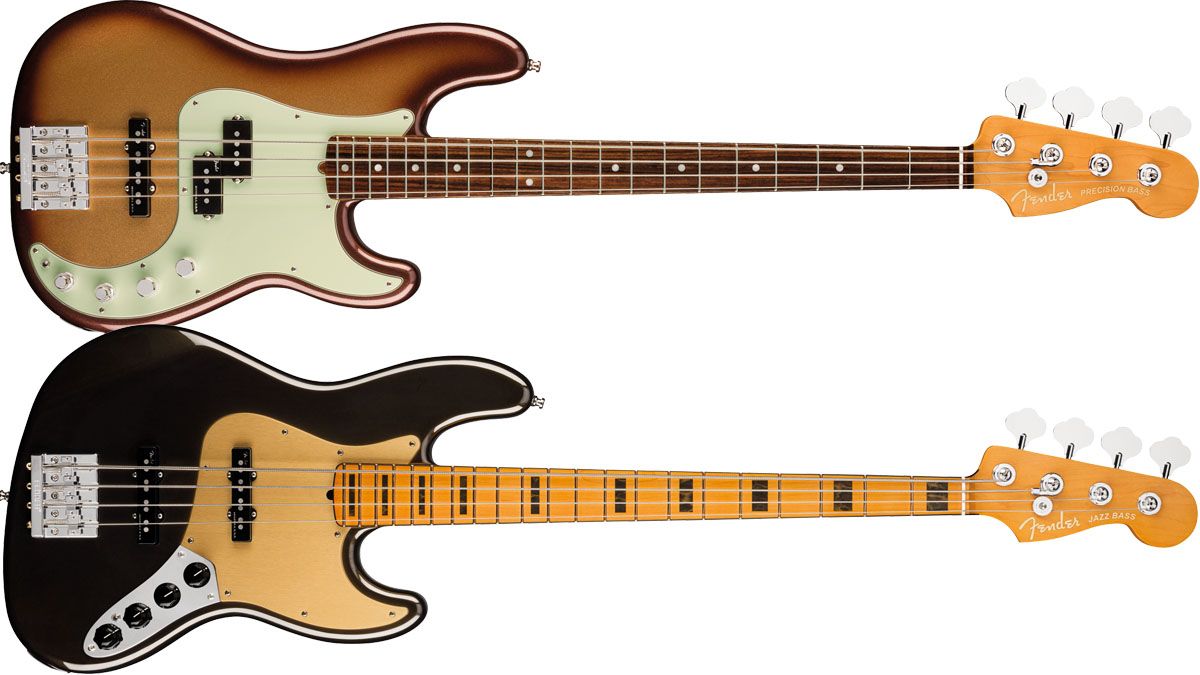Guitar World Verdict
All the tones you expect from a Fender, and much more, with superb playability thrown in.
Pros
- +
Great range of tones.
- +
Some long-overdue updates to the fundamental design.
Cons
- -
A lot of modern active bass alternatives at this price.
You can trust Guitar World
The latest offerings from Fender come in the form of the American Ultra series, an evolution of the American Elite range, aimed at ‘discerning players who demand the ultimate in precision, performance and tone’.
These new models consist of Jazz and Precision basses – the latter with a PJ pickup configuration – with a five-string Jazz option also available. Retailing at $1,899.99/£1959 apiece, they occupy that tricky space at the top end of the mid-range price bracket. With that figure in mind, we’ll be expecting good things. We were sent the four-string Jazzand Precision basses for review.
Build Quality
Each instrument comes with a moulded hardshell case that hasa TSA-accepted centre-locking latch, a ‘military grade’ outer shell and a comfortable handle. The instruments themselves are certainly eye-catching: our Jazz bass might appear black, but it’s actually a very deep bronze colour referred to as Texas Tea.
Paired with the gold-coloured aluminium pickguard, maple board and black Pearloid blocks, it’s suggestive of the instrument’s rich heritage, whilst more modern accoutrements such as the chrome HiMass bridge remind us that we’re looking at aninstrument built for today’s player.
Our Precision bass boasts similar good looks: a Mocha Burst finish, this time paired with a four-ply Tortoiseshell pickguard, rosewood board and dot inlays. Each neck has a modern D profile and the latest versions of Fender’s Ultra Noiseless Vintage pickups, which offer single-coil tones without the usual hum.
Each of our review instruments is finished to a high standard: fretwork was exemplary, the factory-set action is well suited to most players, and a quick peek under the hood reveals neat, minimal wiring. Battery access is simple, with two flip-top hatches on the rear of the instrument housing the 9V batteries.
Sounds and playability
The Jazz bass has a redesigned active preamp that offers a threeband EQ as well as a passive option. We test first in passivemode: soloing each pickup results in the to-be-expected tonal characteristics: warm, vintage tones from the neck pickup, and a punchy, biting sound from the bridge pickup.
All the latest guitar news, interviews, lessons, reviews, deals and more, direct to your inbox!
In passive mode, only a single master tone control is operational, occupying the lower portion of the second stacked pot. Little more is required or expected, however, and in passive mode, the Jazzperforms as you would expect – with the added bonus of the silent operation ofthe Noiseless pickups.
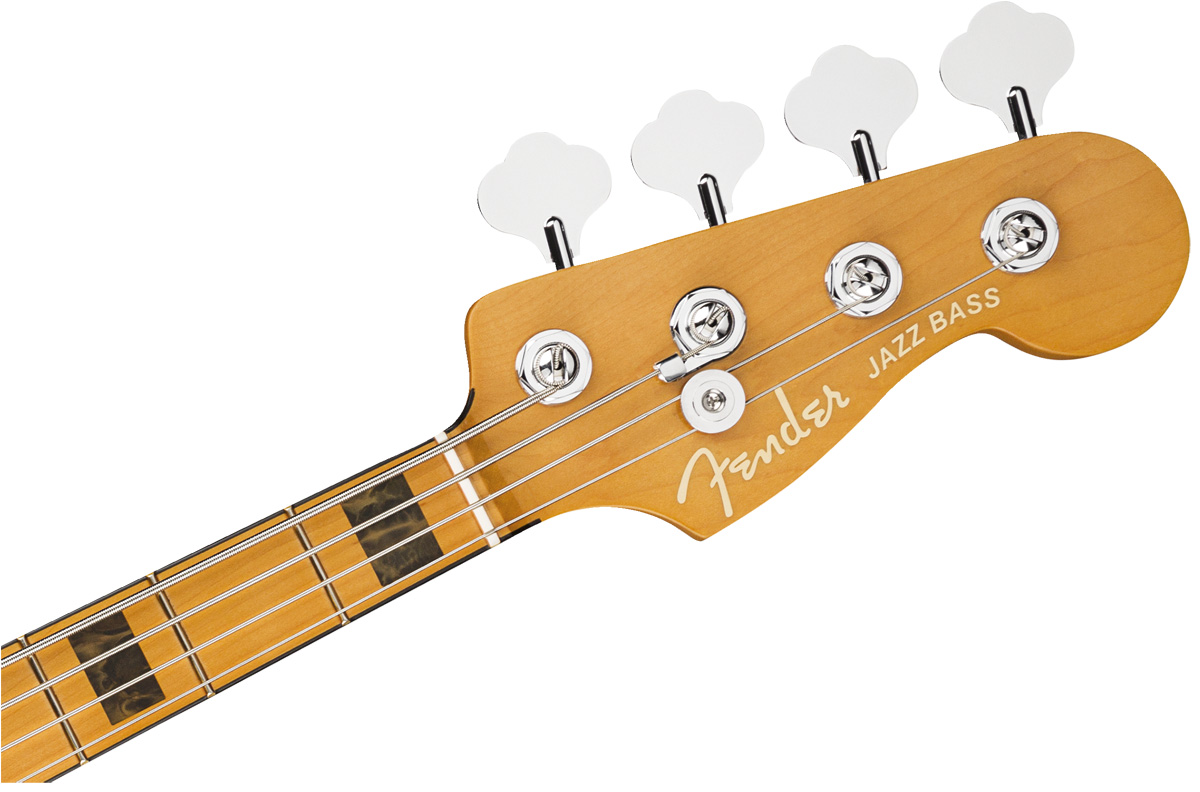
The gold foil logo is standard across all the American Ultra Series and it looks pretty darn classy.
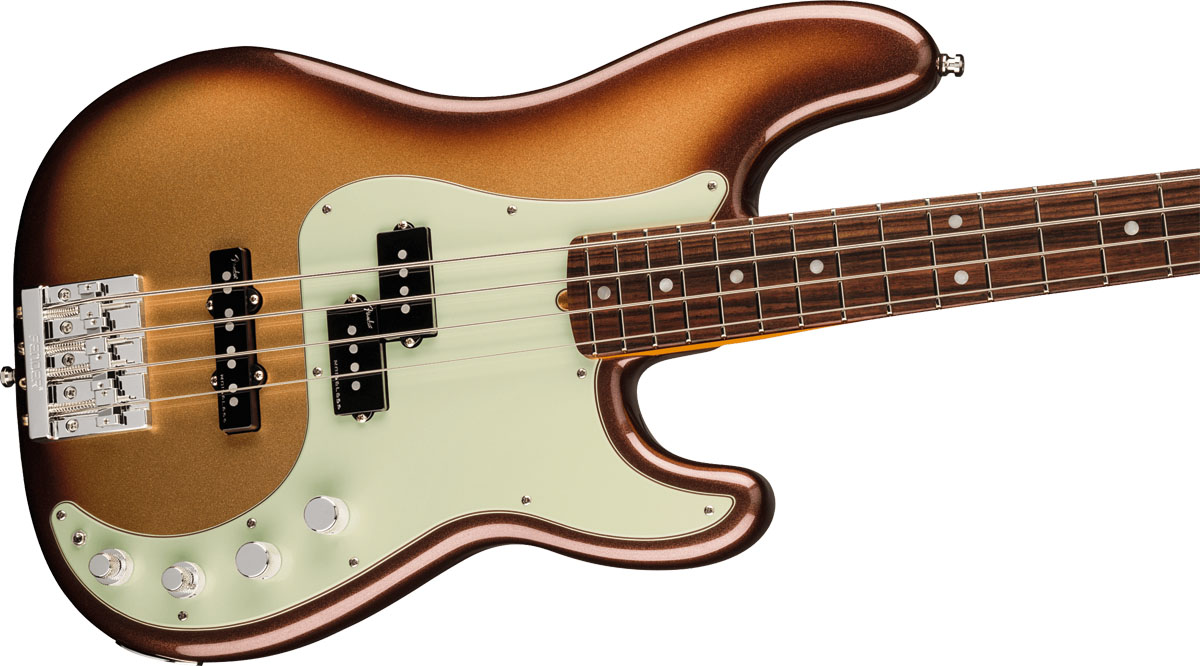
The Mocha Burst is among the stunning finishes debuting in the American Ultra Series.
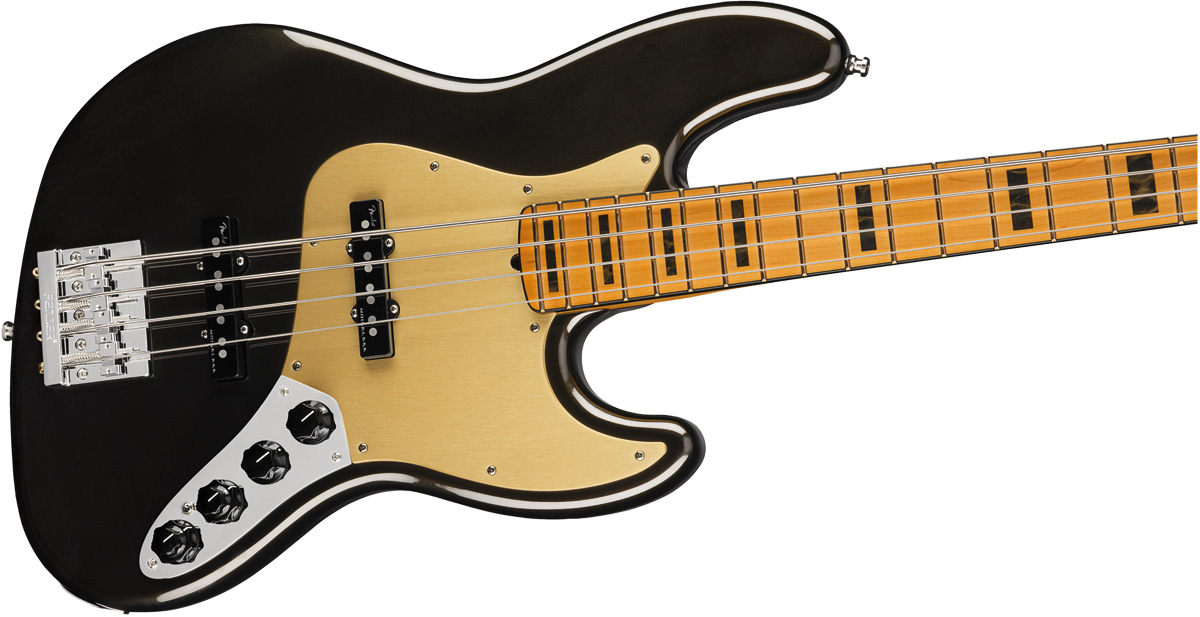
Some of the big ticket features on the American Ultra Series include the HiMass bridge, a new preamp and Noiseless pickups as standard and modern D profile necks.
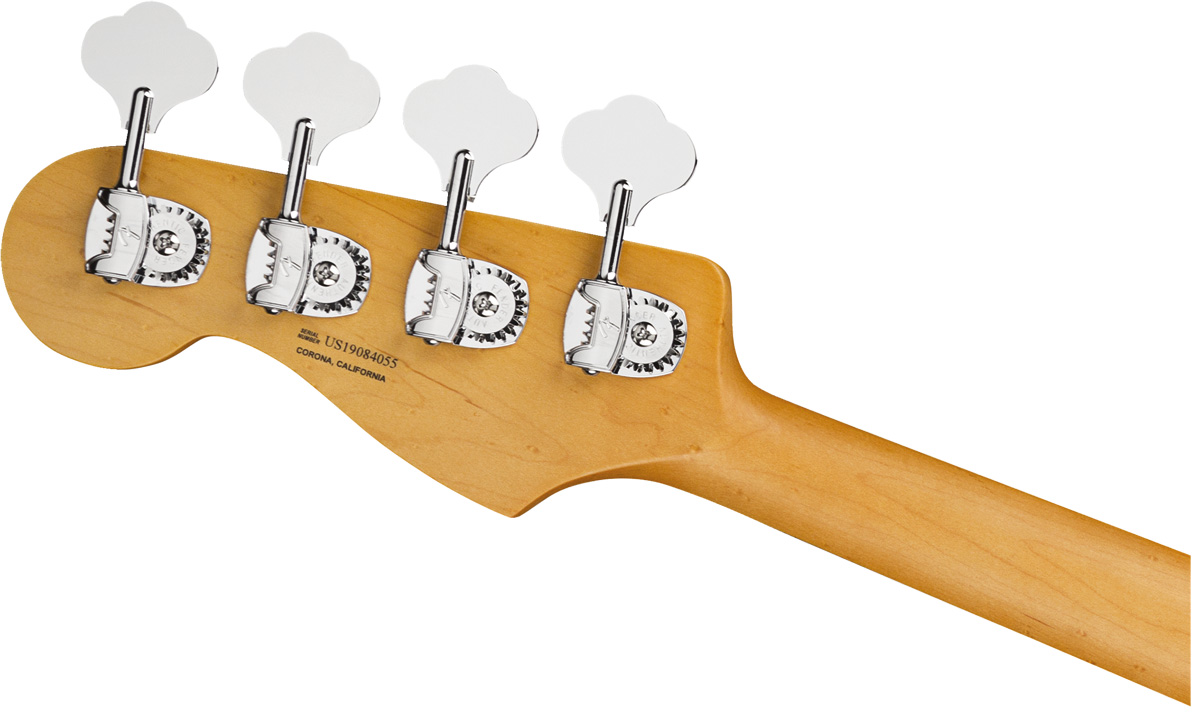
The use of lightweight vintage paddle keys keeps the headstock weight down.
In active mode the tonal palette of the Ultra Jazz is further widened through the addition of a three-band EQ. The treble and bass controls occupy the first stacked control, with the midrange atthe top of the second. Having the option to tweak those classic Jazz tones is certainly appealing, and I found that a subtle boost of the bass frequencies added more ‘meat’ to my go-to slap tone.
Similarly, further bite can be added to Jaco-esque fingerstyle tonesvia the mid-control. I found each active tone control to be well-voiced, and that only subtle nudges are really needed to bringabout some very pleasing tones indeed.
The modern D neck profiles are slim and comfortable and feel well-suited to the wider range of playing techniques typically employed by the modern pro-bassist
The Precision Ultra has the same set of controls as the Jazz, although in passive mode only the neck-position split coil pickup is operational. The passive tone control offers up the traditional P-bass sound palette, from subby low-end warmth through to plectrum-beckoning punch.
In active mode, both pickups are operational, although the most interesting tones come as aresult ofsoloing the neck pickup and tweaking the traditional tones further via the EQ. Favouring the bridge pickup takes the instrument into Jazz bass territory.
In use, these are comfortable instruments to play. As expected of any instrument with a large headstock mass, some neck-dive is present, but this has been minimised through the use oflightweight vintage paddle keys. This was no hardship when standing with the instruments, and just a little more noticeable when seated.
The modern D neck profiles are slim and comfortable and feel well-suited to the wider range of playing techniques typically employed by the modern pro-bassist. The satin finish undoubtedly helps in this regard too. Although not unique to this Fender range, the modern HiMass bridge is undoubtedly a welcome addition, offering improved overall sustain alongside easy adjustments.
Body contouring is comfortable across the instruments and indeed, this is an area in which Fender have made some significant alterations to the classic design. With the Ultra range, Fender have re-sculpted the rear of these basses, resulting in a noticeable difference with regard to upper fret access. Gone is the squared-off heel, replaced by a curved alternative that removes all of the mass that restricted access to the upper frets on all previous Fender basses.
The area around the neck joint is also gently tapered, making the instruments comfortable to play across the entire fingerboard. As welcome as this new feature is, it does beg the question: why has this taken over 60 years? This is a feature that will only really appeal to the relatively small group of players who find a regular need to visit this part of the fingerboard.
Conclusion
Overall, the Ultra basses are fine instruments. They’re well-built, play beautifully and they look fantastic. Those who love classic Fender bass tones will certainly be satisfied: in passive mode, these instruments offer nothing but the sounds that we know and love, with the added bonus of feature updates such as the HiMass bridge, modern D neck profile, improved body sculpting and the noiseless pickups.
However, at this price point, the Ultra range faces fierce competition: for the best part of £2000 there are a huge number of alternatives available, many of which offer features beyond the scope of these instruments, such as an extended fi ngerboard, smaller headstock mass or sleeker body shaping.
In addition, other manufacturers now offer very affordable active Jazz-style instruments, with just as many bells and whistles. So, although the Ultra basses are versatile, contemporary instruments that are perfectly suited to the demands of today’s pro bassist, potential customers will face a dilemma: can they justify the price tag when compared to those more affordable options?
Are the new features enough to justify that price tag? While we have absolutely no hesitation in recommending a test drive of these basses, we can’t ignore the fact that there are many alternatives available at this price point.These basses will also please those who want to take those classic tones further, with the three-band EQ offering further tone-shaping opportunities right there on the instrument.
Specs
- Fender American Ultra Series Precision Bass
- Price: $1,899.99/£1959
- Made In: USA
- Body: Alder or ash
- Neck: Maple
- Fretboard: Rosewood
- Pickups: Ultra Noiseless Vintage Jazz Bass and Ultra Noiseless Vintage Precision Bass
- Controls: Master Volume, Pan Pot (Pickup Selector), Treble Boost/Cut, Midrange Boost/Cut, Bass Boost/Cut, Passive Tone, Active/Passive Mini Toggle
- Hardware: HiMass bridge, Fender “F” Light-Weight Vintage-Paddle Keys
- Case: Fender moulded case
- Fender American Ultra Series Jazz Bass
- Price: $1,899.99/£1959
- Made In: USA
- Body: Alder or ash (transparent finishes)
- Neck: Maple
- Fretboard: Maple
- Pickups: Ultra Noiseless Vintage Jazz
- Controls: Master Volume, Pan Pot (Pickup Selector), Treble Boost/Cut, Midrange Boost/Cut, Bass Boost/Cut, Passive Tone, Active/Passive Mini Toggle
- Hardware: HiMass bridge, Fender ‘F’ Light-Weight Vintage-Paddle Keys
- Case: Fender moulded case
- Fender
